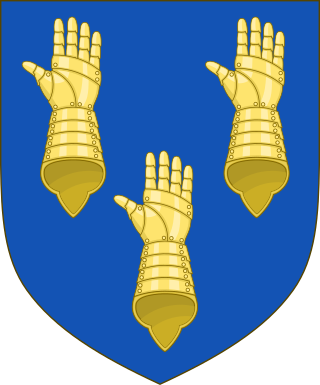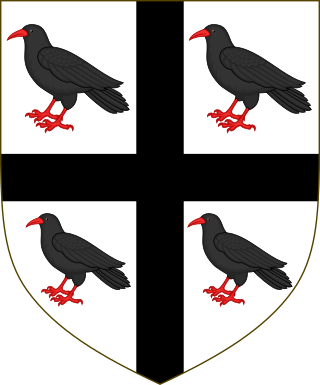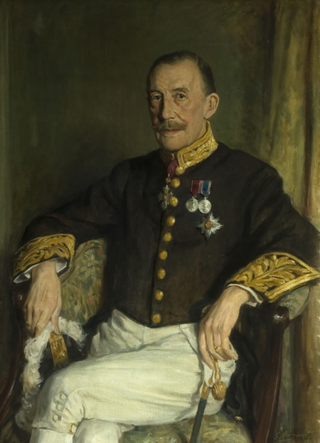Related Research Articles

Marquess Conyngham, of the County of Donegal, is a title in the Peerage of Ireland. It was created in 1816 for Henry Conyngham, 1st Earl Conyngham. He was the great-nephew of another Henry Conyngham, 1st Earl Conyngham, a member of a family of Scottish descent which had settled during the Plantation of Ulster in County Donegal in Ireland in the early 17th century. The 'founder' of the dynasty in Ireland was The Very Rev. Dr. Alexander Cunningham, Dean of Raphoe. The earlier Henry was a member of both the Irish House of Commons and the British House of Commons and served as Vice-Admiral of Ulster and as Governor of the counties of Donegal and Londonderry. In 1753 he was raised to the Peerage of Ireland as Baron Conyngham, of Mount Charles in the County of Donegal, and in 1756 he was created Viscount Conyngham, in Ireland, also in the Peerage of Ireland. In 1781 he was made Baron Conyngham, of Mount Charles in the County of Donegal, with remainder to his nephew Francis Burton, and Earl Conyngham, of Mount Charles in the County of Donegal, which like the creations of 1753 and 1756 was created with normal remainder to the heirs male of his body. The latter titles were also in the Peerage of Ireland. Lord Conyngham was childless and on his death in 1781 the barony of 1753, the viscountcy and earldom became extinct while he was succeeded in the barony of 1781 according to the special remainder by his aforementioned nephew Francis. He was the eldest son of Mary, sister of the first Earl Conyngham, by her husband Francis Burton. The new 2nd Baron Conyngham, who had earlier represented Killybegs and County Clare in the Irish House of Commons, assumed by Royal licence the surname and arms of Conyngham on succeeding to the titles.

Baron Barnard, of Barnard Castle in the Bishopric of Durham, is a title in the Peerage of England. It was created in 1698 for Christopher Vane, who had previously served as a member of parliament for County Durham and Boroughbridge. Vane was the son of Sir Henry Vane the Younger and grandson of Sir Henry Vane the Elder. His grandson, the third Baron, notably served as Paymaster of the Forces and as Lord Lieutenant of County Durham. In 1754 he was created Viscount Barnard and Earl of Darlington, both in the County Palatine of Durham. Lord Darlington was the husband of Lady Grace FitzRoy, daughter of Charles FitzRoy, 2nd Duke of Cleveland, the illegitimate son of King Charles II by his mistress Barbara Villiers, 1st Duchess of Cleveland.

Earl Granville is a title that has been created twice, once in the Peerage of Great Britain and once in the Peerage of the United Kingdom. It is now held by members of the Leveson-Gower family.
Viscount Leathers, of Purfleet in the County of Essex, is a title in the Peerage of the United Kingdom. It was created on 18 January 1954 for the businessman, Conservative politician and public servant Frederick Leathers, 1st Baron Leathers. He had already been created Baron Leathers, of Purfleet in the County of Essex, on 19 May 1941, also in the Peerage of the United Kingdom. As of 2020 the titles are held by his grandson, the third Viscount, who succeeded his father in 1996.

Lord Aylmer, Baron of Balrath, in the County of Meath, is a title in the Peerage of Ireland. It was created in 1718 for the naval commander Matthew Aylmer, the second son of Sir Christopher Aylmer, 1st Baronet, of Balrath. Lord Aylmer's son, the second Baron, represented Rye in the House of Commons. The latter's grandson, the fourth Baron, succeeded his kinsman as seventh Baronet, of Balrath, in 1776. The titles remain united. He was succeeded in both titles by his son, the fifth Baron. He was a general in the Army and served as Governor General of Canada from 1830 to 1835. Lord Aylmer assumed by Royal licence the additional surname of Whitworth in 1825 on the death of his uncle Charles Whitworth, 1st Earl Whitworth. On his death, the titles passed to his younger brother, the sixth Baron. He was an admiral in the Royal Navy.

Baron Hemingford, of Watford in the County of Hertford, is a title in the Peerage of the United Kingdom. It was created 1 February 1943 for the Conservative politician Sir Dennis Herbert. He was a Deputy Speaker of the House of Commons from 1931 to 1943. His son, the second Baron, notably served as Lord Lieutenant of Huntingdon and Peterborough from 1968 to 1974. The title is currently held by Christopher Herbert, who succeeded in 2022.
Baron Grantchester, of Knightsbridge in the City of Westminster, is a title in the Peerage of the United Kingdom. It was created on 30 June 1953 for the banker and Liberal politician Alfred Suenson-Taylor. As of 2019, the title is held by his grandson, the third Baron, who succeeded his father in 1995. In 2003, he replaced the deceased Lord Milner of Leeds as one of the ninety elected hereditary peers that are allowed to remain in the House of Lords after the passing of the House of Lords Act 1999. Lord Grantchester sits on the Labour benches.

Baron Jeffreys is a title that has been created twice, once in the Peerage of England and once in the Peerage of the United Kingdom. The first creation came in the Peerage of England on 16 May 1685 when the lawyer and later Lord Chancellor, Sir George Jeffreys, 1st Baronet, was made Baron Jeffreys, of Wem. He had already been created a Baronet, of Bulstrode in the County of Buckingham, in the Baronetage of England in 1681. The titles became extinct on the death of his son, the second Baron, in 1702, who had no male heir: his daughter, the writer Henrietta Fermor, married the 1st Earl of Pomfret. The estates passed to Jeffreys's widow, Lady Charlotte Herbert, who later remarried as Viscountess Windsor.
Baron Amwell, of Islington in the County of London, is a title in the Peerage of the United Kingdom. It was created on 16 July 1947 for the Labour politician Frederick Montague. He had previously represented Islington West in the House of Commons and served as Under-Secretary of State for Air from 1929 to 1931. As of 2010 the title is held by his grandson, the third Baron, who succeeded his father in 1990.
Baron Kenswood, of St Marylebone in the County of London, is a title in the Peerage of the United Kingdom. It was created in 1951 for the professional violinist and welfare worker for the blind, Ernest Whitfield. As of 2017 the title is held by his grandson, the third Baron, who succeeded in 2016.
Baron Wolverton, of Wolverton in the County of Buckingham, is a title in the Peerage of the United Kingdom. It was created in 1869 for the banker George Glyn. He was the fourth son of Sir Richard Carr Glyn, 1st Baronet, of Gaunt's House, Lord Mayor of London in 1798, himself the fourth son of Sir Richard Glyn, 1st Baronet, of Ewell, Lord Mayor of London in 1758. Lord Wolverton was succeeded by the eldest of his nine sons, the second Baron. He was a Liberal politician and served under William Ewart Gladstone as Paymaster General and as Postmaster General. He was childless and was succeeded by his nephew, the third Baron. He was the eldest son of Vice-Admiral the Hon. Henry Carr Glyn, younger son of the first Baron. He died childless the following year aged only twenty-six, and was succeeded by his younger brother, the fourth Baron. He served as Vice-Chamberlain of the Household from 1902 to 1905 in the Conservative administration of Arthur Balfour. On the death in 1988 of his second but eldest surviving son, the fifth Baron, this line of the family failed. The title was inherited by the late Baron's second cousin, the sixth Baron. He was the grandson of the Hon. Pascoe Glyn, younger son of the first Baron. As of 2011 the title is held by his grandson, the eighth Baron, who succeeded in 2011.
Baron Silkin, of Dulwich in the County of London, is a title in the Peerage of the United Kingdom. It was created on 4 July 1950 for the solicitor and Labour politician Lewis Silkin. The peerage was disclaimed by both his eldest son, the second Baron, and the latter's nephew, the third Baron. When the third Baron disclaimed the title in 2002, the barony of Silkin became the first peerage ever to be disclaimed twice; and the only disclaimer since the House of Lords Act 1999

Baron Ponsonby of Shulbrede, of Shulbrede in the County of Sussex, is a title in the Peerage of the United Kingdom. It was created in 1930 for the politician Arthur Ponsonby. Ponsonby was the third son of General Sir Henry Ponsonby and the great-grandson of Frederick Ponsonby, 3rd Earl of Bessborough. Frederick Ponsonby, 1st Baron Sysonby, was his elder brother. The first Baron's grandson, the third Baron, was also a Labour politician and notably served as Opposition Chief Whip in the House of Lords in the 1980s. As of 2017 the title is held by the latter's only son, the fourth Baron, who succeeded in 1990. He sat on the Labour benches in the House of Lords prior to the passing of the House of Lords Act 1999, when he lost his seat. However, in 2000 he was given a life peerage as Baron Ponsonby of Roehampton, of Shulbrede in the County of West Sussex, and was able to retake his seat in the House of Lords.

Baron Merthyr, of Senghenydd in the County of Glamorgan, is a title in the Peerage of the United Kingdom. It was created in 1911 for the Welsh coal mining magnate Sir William Lewis, 1st Baronet. He had already been created a baronet, of Nantgwyne in the County of Glamorgan, in 1896. The barony is named after the town of Merthyr Tydfil, where Lewis was born. Lord Merthyr's grandson, the third Baron, was Chairman of Committees in the House of Lords from 1957 to 1965 and a Deputy Speaker from 1957 to 1974. The latter was succeeded by his son, the fourth Baron. He disclaimed the peerage for life on 26 April 1977, three weeks after succeeding his father. He did not use his title of baronet either. He died on 5 August 2015.
Baron Milner of Leeds, of Roundhay in the City of Leeds, is a title in the Peerage of the United Kingdom. It was created on 20 December 1951 for the Labour politician James Milner. His only son, the second Baron, was one of the ninety elected hereditary peers that were allowed to remain in the House of Lords after the House of Lords Act of 1999. Like his father Lord Milner of Leeds sat on the Labour benches. As of 2018 the title is held by the latter's only son, the third Baron, who succeeded in 2003.
Baron Brocket, of Brocket Hall in the County of Hertford, is a title in the Peerage of the United Kingdom. It was created on 19 January 1933 for the businessman Sir Charles Nall-Cain, 1st Baronet. He was chairman of the brewing firm of Robert Cain & Sons, which had been founded by his father Robert Cain. Before his elevation to the peerage, Nall-Cain had been created a baronet, of the Node, in 1921. His son, the second Baron, represented Wavertree in the House of Commons as a Conservative. As of 2017 the titles are held by the latter's grandson, the third Baron, who succeeded in 1967.
Baron Fermoy is a title in the Peerage of Ireland. The title was created by Queen Victoria by letters patent of 10 September 1856 for Edmond Roche.
John Derek Page, Baron Whaddon, was a British politician and export agent/consultant.
Frederick John Wise, 1st Baron Wise, was a Labour Party politician in the United Kingdom. He was Member of Parliament (MP) for King's Lynn from 1945 to 1951. He was the younger brother of fellow Labour MP Frank Wise.
The King's Lynn by-election, 1943 was a by-election held for the British House of Commons constituency of King's Lynn in Norfolk on 12 February 1943. The seat had become vacant when the Conservative Member of Parliament (MP) Somerset Maxwell had died in December 1942 from wounds received at the Battle of El Alamein.
References
- ↑ "No. 39420". The London Gazette . 28 December 1951. p. 6740.
- ↑ Google Groups
- Kidd, Charles, Williamson, David (editors). Debrett's Peerage and Baronetage (1990 edition). New York: St Martin's Press, 1990.
- Leigh Rayment's Peerage Pages – Peerages beginning with "W" (part 3) [ self-published source ][ better source needed ]
